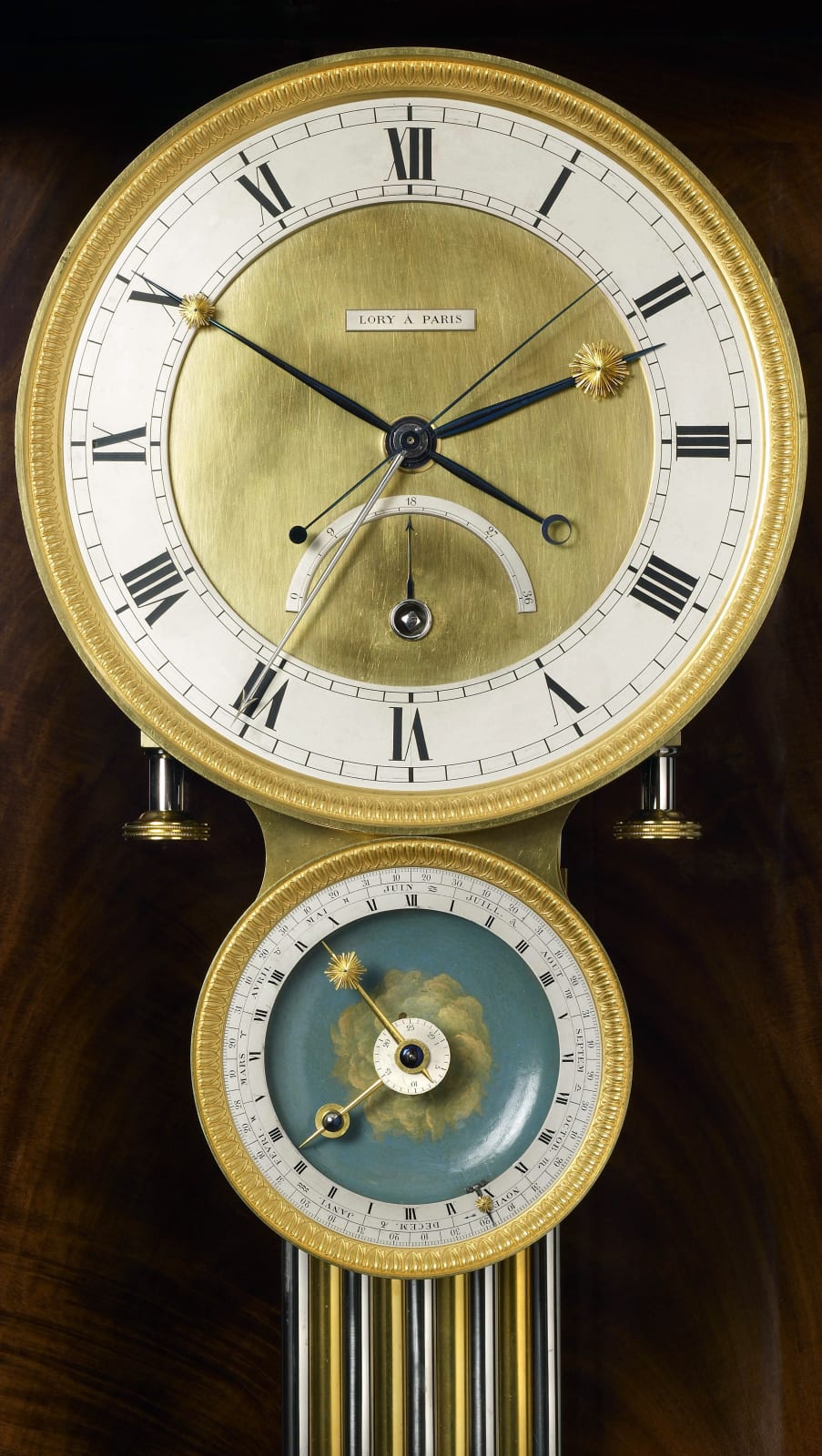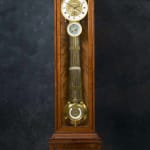Claude-Armand Lory
Provenance
Charles Victor Prévost, Vicomte d'Arlincourt of Château de Saint-Paër, Normandy, who commissioned the clock.
Exhibitions
Almost certainly: Paris, Exposition des Produits de l'Industrie, 1823.
Literature
Antide Janvier, "Recueil de Machines Composées et Exécutées par Antide Janvier", 1827, troisième partie, article II, p. 33 and pl. 4, outlining Antide Janvier's descriptions and illustrations of this particular lunar system, as employed here by Lory.
A very important and rare Restauration Cuban mahogany astronomical longcase regulator by, signed on the dial within the silvered signature shield and on the backplate of the movement Lory à Paris, also inscribed on the movement: Régulateur Astronomique Command par le Géal Baron d'Arlincourt and bearing the coat of arms of Victor Prévost, Vicomte d'Arlincourt and further inscribed 'Régulateur à equation, composé et exécuté par Lory: avec mouvement périodique synodique et journalier de la lune systême de Janvier année 1823, also inscribed with the motto on the thermometer band on the pendulum: Elementa Suis Proprius Armis Victa and further inscribed on a silvered plaque attached to the pendulum: Pendulum de Compensation exécuté par Lory 1823. The gilt brass dial with an egg and dart bezel and outer silvered chapter ring with Roman numerals and inner divisions for the seconds and outer ones for the five minutes, with an applied silvered signature shield above a semi-circular 36 days state of wind aperture with an accompanying blued steel indicator and with a blued steel sweep centre seconds hand as well as a pair of blued steel hands with gilt sunbursts to indicate solar hours and minutes and a further polished steel hand to indicate mean time, the main dial above a further slightly smaller dial with an egg and dart bezel and a silvered chapter ring with double XII hour numerals for the twenty four hour indications, the names and days of the months and the signs of the zodiac, the calendar indications centred by a blue enamel painted sky with central radiating clouds and inner disc showing the ages of the moon, with two gilt brass hands to show the relative positions of the sun and moon, one with a gilt sunburst to indicate the position of the sun and at the other end to indicate the ages of the moon shown on the central lunar disc, the moon hand set with a rotating blue and grey painted globe to show the relative lunar cycle, an outer and much smaller blued steel hand with gilt sunburst revolves once a year to indicate the date and month of the year and the prevailing sign of the zodiac. The massive gilt rectangular brass movement with shaped pillars, blued screws, a five-wheel train with an adjustable precision lever escapement, with jewelled pallets and a steel escape wheel, with a steel shaft descending to the movement for the lower dial which has a five-wheel train and a large kidney-shaped equation cam, there is an adjustable knife edge suspension for the nine rod gridiron pendulum to ensure that the pendulum can be put into place and then lowered onto the knife edge without this being damaged, the pendulum with temperature indications 5-25 degrees centigrade and a finely executed thermometer with silvered scale applied to the bob, having the rare feature of a superbly executed bimetallic strip running around the inside of the bob, the scale indicating the actual temperature while an elongated pointer going up to the pendulum to show the amount of compensation in temperature being made by the pendulum. The very finely executed rectangular shaped Cuban mahogany case with a detachable dentilled pediment, above a glazed front door and sides and solid back containing a concealed compartment to house the weight, the whole on a rectangular plinth with highly figured recessed front and side panels resting on a moulded base
Paris, dated 1823
Height 212 cm.
Precision regulators of this calibre and complexity are extremely rare. Furthermore one does not usually find a clock so copiously inscribed nor indeed one with such a distinguished and interesting provenance. The movement was made by the Parisian clockmaker Claude-Armand Lory (d. after 1825), whose name is associated with precision mechanics, this piece is undoubtedly his very finest and was almost certainly the work he exhibited at the Exposition des Produits de l'Industrie, in Paris 1823, for which he was awarded a silver medal. Lory is recorded as having trained under the celebrated clockmaker Robert Robin (1741-99), who was appointed to King Louis XVI and his wife Marie-Antoinette but also later gained the titles Horloger de la République and Horloger du Directoire. No doubt Lory gained a strong grounding in mechanical expertise from Robin despite certain disagreements between him and the Robin brothers concerning a constant force escapement.
By 1804 Lory was established at rue de Jouiy and then by 1819 had moved to 2 place des Victoires, close to where Jean-Antoine Lépine (1720-1814) had also worked at no 12. When first admitted to show at the Exposition des Produits de l'Industrie in 1804 he gained an honourable mention. He also exhibited there in 1819 and distinguished himself even further at the exhibition of 1823.
One of the many interesting aspects of this regulator is Lory's use of his colleague Antide Janvier's (1751-1835) invention of a unique lunar system, which four years later Janvier published in his "Recueil de Machines Composées et Exécutées par Antide Janvier", 1827. Headed "Description de Nouvelle Cadrature pour les Mouvements de la Lune", Janvier included a full description of its workings as well as detailed diagrams showing different aspects of the lunar movement. Interestingly Janvier's designs did not include the outer annual calendar indicator, implying that this part of the mechanism was possibly Lory's own invention although it was more likely to have been conceived in consultation with Janvier. Janvier was himself one of the greatest mechanical geniuses, whose expertise not only embraced horology but also mathematics and astronomy resulting in some of history's most complex clocks including ones that indicated the tides, a geographical clock and a planetary clock acquired by Louis XVI.
It is also interesting to note the Latin inscription on the pendulum: Elementa Suis Proprius Armis Victa, which loosely translates as 'the elements are overcome by their own weapons'. Such an inscription also appears on thermometer bands on a few other quality French regulators, including ones by Ferdinand Berthoud, Robert Robin and Collin, a pupil of Lépine.
Another inscription on the movement proudly announces that the clock was commissioned by the romantic novelist, poet and dramatic author, Victor Prévost, Vicomte d'Arlincourt (1788-1856), who, known as the 'Prince des Romantiques', was by the early 1820's at the height of his literary career. To this extent he would have desired a regulator befitting of his social standing, which would not only appeal to his intellect but also housed in its fine Cuban mahogany case was a work of art in its own right. Cuban Mahogany, also known as Swietenia mahogany was one of the very finest woods, used by ébénistes for the most luxurious pieces. As testament to his standing at this period, the year prior to the completion of his clock, Arlincourt had had his portrait painted by Robert Lefèvre (1755-1830). Exhibited at the Salon des Artistes Français 1822 and now in the Musée du Louvre, Lefèvre's portrait shows Arlincourt taking a pose from his celebrated novel Le Solitaire, in which he appears as the true Romantic hero standing on a craggy ridge against torrents of water and a mountainous landscape. The year after his regulator was made Arlincourt sat for Jean-Baptiste Isabey (1767-1885) who executed a miniature portrait of him. That pastel, also housed at the Louvre, portrays the author holding a notebook inscribed with the names of his greatest masterpieces 'la caroleide, le solitaire, le rénégat, Ipsiboé.....'.
Victor Prévost d'Arlincourt came from a long and distinguished noble family. He was born at Château de Mérantais, with its fine avenue of limes leading to the Parc de Versailles, on 24th September 1788 (as noted in his main biography "Le Vicomte d'Arlincourt, Prince des Romantiques" by Alfred Marquiset, 1909, though other accounts give his birth date as 1789). Arlincourt's youth coincided with the reign of Terror and on 8th May 1794 his father Louis-Adrien Prévost d'Arlincourt alongside Antoine Lavoisier and twenty-four other fermiers-généraux was executed at the guillotine. Almost immediately Victor along with his brother Charles and their mother Marie Jeanne née Gourgon de Précy (b. circa 1751 d. 1813), were taken to Lépinoy, another family property in Picardie. Arlincourt remained there until he purchased Château de Saint-Paër in Normandy, where this regulator was to be housed.
At the beginning of the Empire, Marie Jeanne Arlincourt appealed on behalf of her two sons Charles and Victor to the Emperor Napoleon, who duly nominated Charles equerry to the King of Naples and Victor equerry to Madame de Mère, 1808. That same year Victor married Marie Thérèse Joséphine Laure de Cholet, the daughter of the sénateur and comte de l'Empire François-Armand Cholet. At Lépinoy the following year came the birth of their first child Athénaïs (who was later to marry comte Etienne Bernard de Sassaney) and in 1814 the birth of their second daughter Mathilde (who died in 1839). In 1810 Arlincourt wrote his first tragedy Matinée de Charlemagne, which he dedicated in part to Napoleon but was refused by the Théâtre-Français. The following year Napoleon nominated him an auditor of the Council of State and then enrolled him in the army as an Intendant during the Spanish Campaign and the capture of Terragone.
Having been a staunch supporter of Napoleon, after the Emperor's overthrow in 1814, Arlincourt aligned himself with the Bourbons gaining the confidence of Louis XVIII, who awarded him the title of Chevalier de l'Ordre de la Légion d'Honneur. In 1818 Arlincourt wrote an epic poem also titled Charlemagne or Caroléide, which he presented to the Académie Français but his candidature only received one vote. Undeterred he began writing Le Solitaire, which was published in 1821 and brought him considerable acclaim. Within a few months his novel had been reprinted a dozen times, it was also translated into ten different languages and was to inspire numerous songs and paintings as well as Vincenzo Bellini's opera La Straniera of 1828. More success followed with the publication of three further novels, Le Renégat (1822), Ipsiboé (1823) and L'Etrangère (1825). Arlincourt gained a great following, especially among the female public, not least from the duchesse de Berry who was entertained at his newly acquired Château de Saint-Paër with a great pageant and theatrical performances.
Despite a strong following, Arlincourt's style came under attack. In an attempt to reassert himself in 1826 a production of his play Le Siège de Paris appeared at the Théâtre-Français, which was also severely attacked by the critics. He then commenced writing a number of historical novels and during 1841 and 1844 made two prolonged tours of Europe. On his return to France he wrote a new play La Peste Noire, which was performed in 1845 at the Théâtre de l'Ambigu-Comique but was sadly received as coldly as his first but his article Dieu le Veut! of 1848 did much to revive his popularity. In 1847 Arlincourt's first wife died but four years later in 1851 he remarried Madame Beaudon de la Maze, née Elizabeth Contenot de Laneuville. Shortly before this, he had travelled to Italy resulting in his L'Italie Rouge in which he recounted his passionate concerns over the Italian unification movement known as the Risorgimento; this again gained him acclaim among his French readers. This and another anti-revolutionary article also of 1850 were to be his last publications. Arlincourt died a few years later on 22nd January 1856. Today Arlincourt's name has fallen into obscurity although his regulator, in addition to his two portraits in the Musée du Louvre stand as testament to his once much celebrated career.



